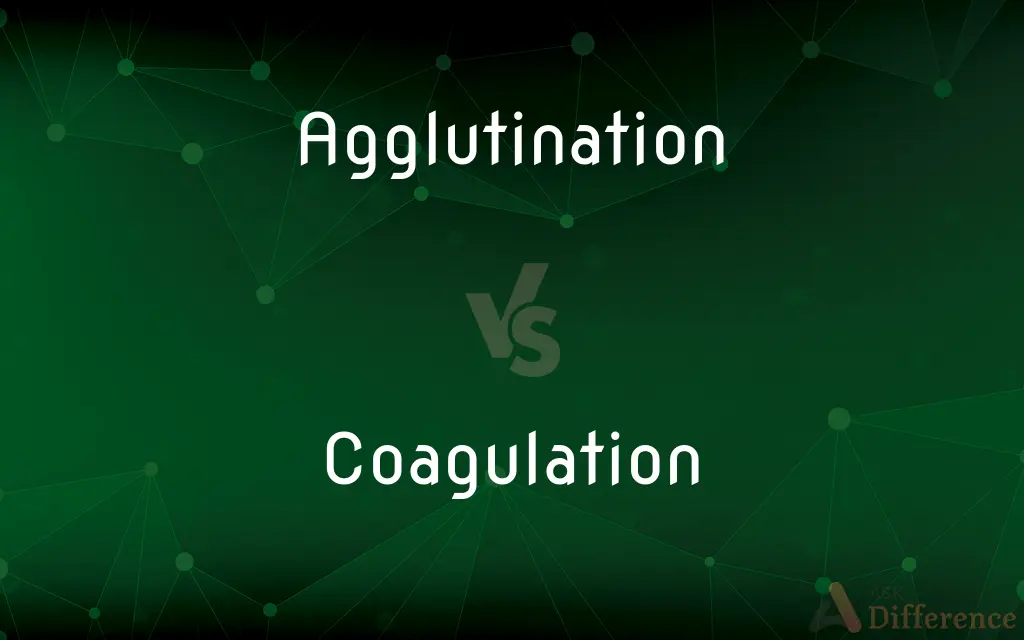Agglutination vs. Coagulation — What's the Difference?
By Tayyaba Rehman & Maham Liaqat — Updated on March 30, 2024
Agglutination involves the clumping of particles, like cells, in response to an antigen-antibody reaction, while coagulation refers to the process of blood turning from a liquid to a gel, forming a clot.

Difference Between Agglutination and Coagulation
Table of Contents
ADVERTISEMENT
Key Differences
Agglutination is a specific immunological reaction where antibodies bind to antigens on the surface of particles (such as bacteria or red blood cells), causing them to clump together. This mechanism is crucial for identifying and isolating foreign substances in the body. Coagulation, on the other hand, is a complex physiological process involving a cascade of reactions that lead to blood clotting. It is vital for stopping bleeding and involves the transformation of fibrinogen into fibrin, which forms a mesh that traps blood cells.
While agglutination primarily deals with the body's immune response to foreign particles, coagulation is part of the hemostatic process, preventing excessive bleeding. Agglutination can occur in both in vivo (within the body) and in vitro (outside the body, under laboratory conditions) settings, used diagnostically to detect blood type or pathogens. Coagulation, however, is a naturally occurring process in the body that can be influenced by internal factors (such as genetic conditions or diseases) and external factors (such as medications).
The substances involved in agglutination are antibodies and antigens, while coagulation involves a series of plasma proteins, chiefly fibrinogen, and platelets. Agglutination's primary role is in the immune defense mechanism and diagnostic applications, highlighting its utility in medical testing and research. Coagulation's role is critical in wound healing and maintaining vascular integrity, with impairments leading to conditions like hemophilia or thrombosis.
One key difference is the nature of the substances that aggregate: agglutination involves cells or particles, whereas coagulation involves blood components forming a gel-like structure. Moreover, the triggers for agglutination and coagulation differ, with the former induced by antigen-antibody interactions and the latter by a series of enzymatic reactions following vascular injury.
Comparison Chart
Definition
Clumping of particles due to antigen-antibody reaction.
Process of blood turning from liquid to gel to form a clot.
ADVERTISEMENT
Main Substances
Antibodies and antigens.
Plasma proteins (especially fibrinogen) and platelets.
Process Role
Immune response and diagnostic testing.
Hemostasis (stopping bleeding) and wound healing.
Occurrence
Both in vivo and in vitro.
Primarily in vivo.
Key Importance
Identifying foreign substances in the body and in diagnostic labs.
Preventing excessive bleeding and facilitating wound repair.
Conditions Affected
Used to detect blood types, infections, and autoimmune diseases.
Disorders like hemophilia (impaired clotting) and thrombosis (excessive clotting).
Compare with Definitions
Agglutination
Visible to the naked eye under certain conditions.
Agglutination can be seen as clumping in blood tests.
Coagulation
Essential for wound healing and maintenance of blood vessels.
Coagulation seals wounds and supports tissue repair.
Agglutination
Involves antibodies binding to specific antigens.
Agglutination occurs when antibodies recognize foreign cells.
Coagulation
Blood's process of forming clots to stop bleeding.
Coagulation is crucial after an injury to prevent excessive blood loss.
Agglutination
Can detect pathogens in samples.
Agglutination tests help diagnose bacterial infections.
Coagulation
Involves transformation of fibrinogen to fibrin.
Fibrin forms a mesh that traps cells to create a clot.
Agglutination
Used in both research and clinical diagnostics.
Laboratories use agglutination to detect certain diseases.
Coagulation
Impaired in conditions like hemophilia.
People with hemophilia have a slower coagulation process.
Agglutination
Immunological reaction causing particles to clump.
Blood typing tests use agglutination to identify blood groups.
Coagulation
Can be externally influenced by medications.
Anticoagulants are prescribed to prevent unwanted blood clots.
Agglutination
Agglutination is a linguistic process of derivational morphology in which complex words are formed by stringing together morphemes without changing them in spelling or phonetics. Languages that use agglutination widely are called agglutinative languages.
Coagulation
Coagulation, also known as clotting, is the process by which blood changes from a liquid to a gel, forming a blood clot. It potentially results in hemostasis, the cessation of blood loss from a damaged vessel, followed by repair.
Agglutination
The act or process of agglutinating; adhesion of distinct parts.
Coagulation
To cause transformation of (a liquid or sol, for example) into or as if into a soft, semisolid, or solid mass.
Agglutination
A clumped mass of material formed by agglutination. Also called agglutinate.
Coagulation
To become coagulated
As it cooled, the sauce began to coagulate.
Agglutination
(Biology) The clumping together of cells or particles, especially bacteria or red blood cells, usually in the presence of a specific antibody or other substance.
Coagulation
The precipitation of suspended particles as they increase in size (by any of several physical or chemical processes)(e.g. of proteins)
Agglutination
(Linguistics) The formation of words from morphemes that retain their original forms and meanings with little change during the combination process.
Coagulation
The process by which blood forms solid clots.
Agglutination
The act of uniting by glue or other tenacious substance; the state of being thus united; adhesion of parts.
Coagulation
Similar solidification of other materials (e.g. of tofu).
Agglutination
(linguistics) Combination in which root words are united with little or no change of form or loss of meaning. See agglutinative.
Coagulation
The change from a liquid to a thickened, curdlike, insoluble state, not by evaporation, but by some kind of chemical reaction; as, the spontaneous coagulation of freshly drawn blood; the coagulation of milk by rennet, or acid, and the coagulation of egg albumin by heat. Coagulation is generally the change of an albuminous body into an insoluble modification.
Agglutination
The clumping together of red blood cells or bacteria, usually in response to a particular antibody.
Coagulation
The substance or body formed by coagulation.
Agglutination
The act of uniting by glue or other tenacious substance; the state of being thus united; adhesion of parts.
Coagulation
The process of forming semisolid lumps in a liquid
Agglutination
Combination in which root words are united with little or no change of form or loss of meaning. See Agglutinative, 2.
Agglutination
A clumping of bacteria or red cells when held together by antibodies (agglutinins)
Agglutination
The building of words from component morphemes that retain their form and meaning in the process of combining
Agglutination
The coalescing of small particles that are suspended in solution; these larger masses are then (usually) precipitated
Common Curiosities
What triggers agglutination?
Agglutination is triggered by the interaction between specific antigens and antibodies.
What role do platelets play in coagulation?
Platelets aggregate at the site of injury, forming a temporary plug and releasing chemicals that trigger the coagulation cascade.
How does coagulation contribute to wound healing?
Coagulation forms a clot that stops bleeding and provides a matrix for new tissue growth, aiding in wound healing.
Is agglutination harmful?
While agglutination plays a role in immune defense, inappropriate agglutination (as in autoimmune diseases) can be harmful.
How are agglutination and coagulation measured or observed?
Agglutination is observed through laboratory tests that mix antibodies with samples, while coagulation is measured by clotting time and other blood tests.
Can agglutination occur without an immune response?
Agglutination is part of the immune response, specifically triggered by antibody-antigen interactions.
Can coagulation be artificially initiated?
Yes, coagulation can be artificially initiated or enhanced using medications like clotting factors or anticoagulants to manage clotting disorders.
Are there conditions that affect both agglutination and coagulation?
Conditions affecting the immune system or blood components can influence both processes, but they are generally distinct in their pathologies and treatments.
Can both agglutination and coagulation be beneficial?
Yes, both are essential biological processes: agglutination for immune defense and diagnostics, and coagulation for preventing blood loss and facilitating wound repair.
How is inappropriate coagulation managed?
Inappropriate coagulation, such as thrombosis, is managed with anticoagulants that slow down the clotting process.
Share Your Discovery

Previous Comparison
Probe vs. Primer
Next Comparison
Cnidarian vs. PlatyhelminthesAuthor Spotlight
Written by
Tayyaba RehmanTayyaba Rehman is a distinguished writer, currently serving as a primary contributor to askdifference.com. As a researcher in semantics and etymology, Tayyaba's passion for the complexity of languages and their distinctions has found a perfect home on the platform. Tayyaba delves into the intricacies of language, distinguishing between commonly confused words and phrases, thereby providing clarity for readers worldwide.
Co-written by
Maham Liaqat














































